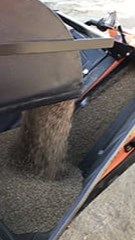KINDERSLEY — Fertilizers have become more costly in recent years. To assist with getting the most out of your fertilizers, there are a few application methods that can be used for distribution. Two methods for distribution into the soil are deep banding of granular or anhydrous ammonia, as well as broadcast spreading of a granular product – which is not recommended. The timing of the application is crucial to obtaining the most efficient use of the product. It is important to follow the 4Rs of fertilizer application. These recommendations include applying fertilizer at the: Right Source, Right Rate, Right Time and Right Place.
Banding of granular fertilizer or with anhydrous ammonia can be done in the fall after harvest or within the springtime prior to seeding. The key to success is ensuring the applications are done when soil is cool.
For a proper deep band, the fertilizer depth should be at least three inches or 7.5 centimetres below the soil surface. If soil temperature is below 5 C, then it will have a decreased tendency towards volatilization or leaching. If the soil has too much moisture, there is a risk of fertilizer leaching or volatilizing. If it is too dry, then there is an increased risk of the soil not sealing over the band of fertilizer and increased losses through volatilization into the environment.
The time of year in which fertilizer is applied is also very important. An option some producers have taken is to broadcast spread fertilizer in the fall. There is a unique set of risks associated with later-season applications. Care must be taken when considering in which field the product is spread. If the field happens to be very hilly, there is an increased risk of spring run-off containing the fertilizer. Run-off can contaminate waterways, which is something that causes various ecological problems, and it represents an investment loss for the producer.
While the practice of spreading nitrogen fertilizer in the winter on frozen or snow-covered ground is done, recent research has shown that banding produces greater yields. If a producer chose to apply fertilizer from mid-November to early April, a nitrogen product that has both a urease and a nitrification inhibitor should be used to prevent unnecessary economic losses and to reduce possible negative effects on the environment.
Selecting a product to use is as important as soil moisture status and temperature. Straight urea (46-0-0) that is spread on the surface is at much higher risk for losses than fertilizer that is banded deeper or placed near the seed row. If urea fertilizer is treated with a nitrogen stabilizer, it can help control the rate at which urea volatilizes. A product such as Environmentally Stable Nitrogen is not suitable for spreading, this is a more suitable product for deep banding or placing in or around the seed row.
— Erica Yaskowich, Ag Dip, ATechAg is a Crops Extension Specialist at Kindersley
Bookmark SASKTODAY.ca, Saskatchewan's home page, at this link.




